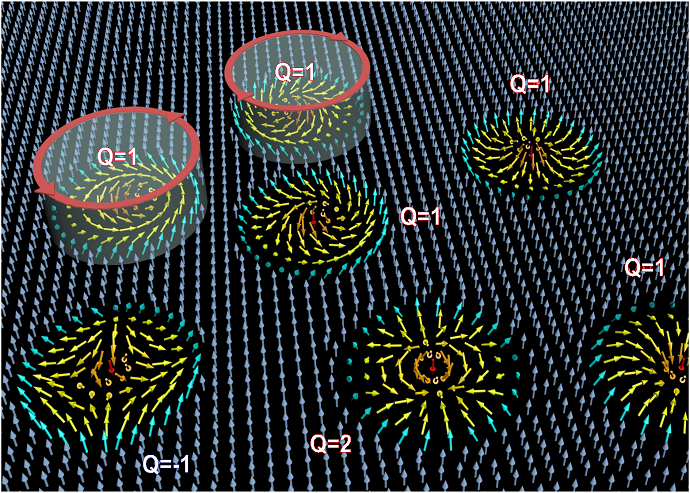Frustrated magnets point towards new memory

Theoretical physicists from the University of Groningen, supported by the FOM Foundation, have discovered that so-called ‘frustrated magnets’ can produce skyrmions, tiny magnetic vortices that may be used in memory storage. This discovery opens up a new class of materials for scientists working on ‘skyrmionics’, which aims to build memory and logic devices based on skyrmions. The results are published on today's Nature Communications.
The field of skyrmionics has developed rapidly over the last few years. The very small (around 10 nanometre) magnetic vortices could provide a new way to build memory and logical devices with a very low energy use. ‘In fact, a computer memory system based on magnetic bubbles, which are basically very large skyrmions, was invented in the 1967 at Bell Labs’, explains Maxim Mostovoy, Associate Professor of Theoretical Physics at the University of Groningen. This bubble memory was rapidly overtaken in the 1980s by much smaller silicon-based memory and is now only used for niche applications – it is very robust, has no moving parts and can operate in harsh environments.
Frustrated magnet
So far, skyrmions are only produced in special materials called chiral magnets. The lattice structure of these magnets is chiral, which means the crystal lattice does not have the same properties as its mirror image. ‘To advance the field, new classes of materials are needed’, says Mostovoy. With his post-doc Andrey Leonov (currently working at the Technische Universität Dresden), he discovered that magnetic frustration can produce skyrmions.
In a normal magnet, the magnetic moments are aligned. In a frustrated magnet, interactions favouring parallel magnetic moments compete with interactions favouring antiparallel magnetic moments. Mostovoy: ‘This means the magnetic moments in the crystals are not happy – they are forced to coil into magnetic spirals.’ An applied magnetic field transforms the spiral into a magnetic crystal composed of skyrmions.
Energy efficient
‘What is more, we found that skyrmions in frustrated magnets have more interesting physical properties than skyrmions in chiral magnets’, says Mostovoy. ‘ For instance, magnetic moments inside the “frustrated” skyrmions can rotate, whereas in chiral magnets they are rigid’. The rotation is coupled to the electric dipole moment of the skyrmion, which can be used to store extra information. In chiral magnets information is encoded in skyrmion positions: 1, if a skyrmion is present, and 0, if it is absent. In frustrated magnets 1/0 can correspond to the up/down directions of the electric dipole moment. This latter type of storage is more energy efficient.
Also, whereas skyrmions in chiral magnets can be moved through the material using an electric current, in frustrated magnets they can be moved using an electrical field. ‘This requires no current, which means a lower energy use and less heat production for potential applications’.
The discovery of skyrmions in frustrated magnets so far relies on theory. The existence and properties of the new skyrmions are described by Leonov and Mostovoy using modelling studies. ‘We are hoping experimental physicists will confirm our findings soon.’ The challenge will be to find a material which shows skyrmions at room temperature, as required for practical applications. This has already been achieved for chiral magnets, and Mostovoy is hoping that this can be repeated in the frustrated magnets. ‘It is a very interesting class of materials; in our paper we also predict some other interesting topological states in these frustrated magnets’.
More information
Article: Frustrated magnets point towards new memory
Reference: A. O. Leonov and M. Mostovoy, Multiply periodic states and isolated skyrmions in an anisotropic frustrated magnet. Nature Communications DOI: 10.1038/ncomms9275
Contact information: prof. Maxim Mostovoy, Department Theorie van de Gecondenseerde Materie — Zernike Institute for Advanced Materials, University of Groningen.
More news
-
11 December 2025
Stormy planets and an unexpected atmosphere
-
09 December 2025
University of Groningen Professor at COP30: ‘There is always drama’
